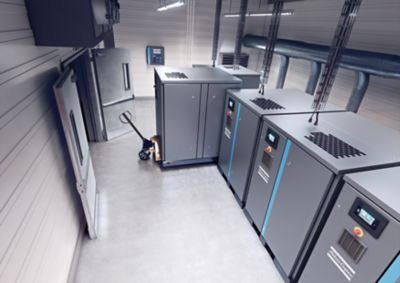Connected compressors and Industry 4.0 – From then to now
by Stef Lievens, Business Line Manager at Atlas Copco Compressors
The term Internet of Things (IoT) has become ubiquitous in recent years and is now seemingly being applied to any instance in which a device is connected, communicative and data-driven; whether it is a smartphone, fridge freezer or car. However, it is arguably the manufacturing sector that stands to benefit the most, with the Industrial Internet of Things (IIoT) envisaged as a positive force for change that is already beginning to see the introduction of sophisticated robotics in the workplace and smart components that communicate their own assembly instructions to the production line. The challenge for equipment suppliers is that companies are now moving beyond talking about the theory behind Industry 4.0 to wanting to know how it can and will be applied in practice.
Reading time: 7 minutes (1190 words)
How do you apply industry 4.0 to air compressors?
Photo: Stef Lievens
Intelligent asset management for compressed air systems
For some time now, smart controller technology has enabled plant managers to keep track of how their compressor is performing via MODBUS or PROFIBUS internet connections to a central plant management system. These types of control system are effectively the ‘brain’ of a compressor: collecting data via built-in sensors, processing it and then delivering plant managers with an overview of how their compressed air system is performing. More recent advances have enabled compressor controllers to be connected to mobile devices, tablets and smartphones through systems such as SMARTLINK, which facilitates remote monitoring over a secure network. The end result is that operators can keep track of key parameters including pressure, flow, motor and dryer speeds and then make adjustments when necessary via a compressor’s manual interface. This enables varying production demands to be accommodated and can help plant managers improve efficiency and save energy.
How does preventive maintenance reduce the risk of breakdowns?
This enables maintenance and service engineers to remotely track indicators such as specific energy and compressed air pressure calculations so that immediate improvements can be made when needed. During this process data is gathered, compared, and analysed; and, when required, warnings can be sent out in order to prevent downtime and to allow local service providers to plan and prepare their interventions.
For instance, when a period of cold weather caused a cereal manufacturer’s compressors to run at a particularly low ambient temperature, a remote data monitoring programme picked up warnings from the units’ electronic condensate drains and triggered a visit to the site by a service engineer. This early intervention saw the customer fit temporary heaters to prevent the drains freezing up, which could have led to compressor element damage, condensate reaching the air network, and substantial breakdown costs.
In another use case a remote data monitoring system picked up an instance where the element temperatures were inefficiently high in all of the compressors at a steel manufacturer’s site. On inspection, a service engineer found that the compressor room was poorly ventilated, leading to a temperature of +40C in the room. A complete re-design of the compressor room was recommended. In the meantime, service engineers made sure the compressor coolers were kept clean and the oil was topped up to prevent overheating. What this all illustrates is that the application of connectivity and remote condition monitoring technology within compressed air equipment is neither new nor incompatible, with great scope for further adoption and opportunities for the IoT to enhance best practice in compressed air operations. This could ultimately lead to a situation where compressed air systems operate independently as cyber physical systems in their own right, making autonomous adjustments to pressure and flow to facilitate process improvements. This will not eliminate the role of the compressor operator however. There will still be a vital position for human operators as an interface between compressors and the wider smart factory environment, which is illustrated by the benefit that remote data monitoring equipment is having now in facilitating preventative maintenance and improving uptime.
Get the latest news and stories from Atlas Copco straight to your inbox Subscribe to our monthly Fresh Air newsletter
References
1. Worldwide Spending on the Internet of Things Forecast to Reach Nearly $1.4 Trillion in 2021, According to New IDC Spending Guide:
References
1. Worldwide Spending on the Internet of Things Forecast to Reach Nearly $1.4 Trillion in 2021, According to New IDC Spending Guide:
References
1. Worldwide Spending on the Internet of Things Forecast to Reach Nearly $1.4 Trillion in 2021, According to New IDC Spending Guide:
References
1. Worldwide Spending on the Internet of Things Forecast to Reach Nearly $1.4 Trillion in 2021, According to New IDC Spending Guide: http://www.businesswire.com/news/home/20170614005185/en/Worldwide-Spending-Internet-Things-Forecast-Reach-1.4
Smartlink The SmartLink solution is divided into three options: Service, Uptime and Energy. SmartLink Service enables the user to easily schedule maintenance visits as they have an overview of machine data and the time left before a service is due. The second option, SmartLink Uptime allows the end user to be informed by email or SMS message if there is a problem with the compressed air production. Without this safeguard the user has to be alert for warnings on the compressor system but even daily checkups do not offer 100 per cent security. Based on the SmartLink information, the necessary actions can be taken to avoid the risk of a breakdown − and it is possible to visit the website at any time to see the actual warning/shutdown status of the machines as well as a history of previous notifications.
Get the latest news and stories from Atlas Copco straight to your inbox Subscribe to our monthly Fresh Air newsletter

